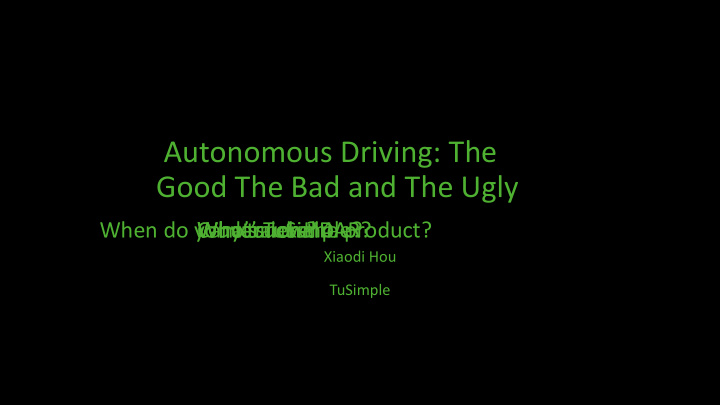



Autonomous Driving: The Good The Bad and The Ugly When do you launch the product? Who’s TuSimple? What’s level 4 Why trucks? Camera or LiDAR? Xiaodi Hou TuSimple
Building an autonomous truck
4 pillars of autonomous driving Algorithms Process Product Infrastructure
Algorithms Algorithms Process Product Infrastructure
Algorithms • “Typical” challenges • D etection, tracking, localization, pose estimation, planning, control… • More for trucks! • Wider, and longer (430% of a Camry), slow accelerate/decelerate • Fuel matters
Perception for trucks Absence of “superior” controllability Long horizon motion planning Long term behavior prediction of others Long range perception
A superior pilot uses his superior judgement to avoid situations which require the use of his superior skill. -- Frank Borman
The more boundless your vision, the more real you are. --Deepak Chopra
650m away
From algorithm to product • Effective algorithms always have an impact on products • Why most academic papers are not applicable • False positive/false negative cost • Indirect implications/narrow application • Computational/implementation cost
Infrastructure and process Algorithms Process Product Infrastructure
What do we need • Infrastructure • Big data, deep learning • Simulation, real-time systems • Process • Data annotation, vehicle testing • Continuous integration, benchmarking
What do we REALLY need
On big data
Trucks can generate big data cheaply • Mileage accumulation: • 45 miles/hr * 20hr/day * 25day/mo = 22,500 miles/mo • Cost-per-mile • $1.8/mile operating cost - $1.6/mile revenue = $0.2/mile • Sampling density • Fixed routes (1D structure)
On data digestion
“Divide and conquer”? • Software engineering methodology • Easy to scale-up the dev team • 3x resources = 3 problems to be solved (patched) simultaneously • Steady progress • Regression test
“Divide and conquer” won’t work • AI systems are not typical software systems • Every node contributes to the noise , without making an error • Team division precludes architectural evolution • How many cases must a system fix, before you call it level-4? • Every “fix” is a technical debt, making future fixes harder
TuSimple’s design philosophies • AI engineering is missing coding : software engineering algorithm : AI engineering
TuSimple’s design philosophies • All about generalization • Each corner case is a reminder • Regression tests
The evolution of autonomous driving systems
The Kardashev scale Type I civilization: 10 16 W Type II civilization: 10 26 W Type III civilization: 10 36 W
Comparable infrastructure & process Single vehicle 5 vehicle fleet 50 vehicle fleet Command-line + Fully automated Raw data transfer Flash disk networking pipeline Manual deployment of Fully automated Algorithm deployment In vehicle deploy/debug packages pipeline Superior driver + Protocol-based test + Road testing Superior driver protocol conservative AI Statistical learning Data digestion Naked eye Hashtag based development
No matter how much funding, or how many algorithm geniuses you have, you can’t build a level 4 product with shaky infrastructure/process.
The missing evaluation metrics
How about Miles-Per-Intervention (MPI)
Interpretations How far are we to achieve driverless automation?
Two types of the fleet • Validation • Stable release of hardware + software • Sufficient coverage of the operational design domain • Significant sampling density
Two types of the fleet • Development • Expected to fail • Rapid iterations • Specific domains and scenarios to check
Understanding interventions • Inefficient maneuvers: benign • waiting too long, detour, slowing down, stopped at the roadside • Traffic rule violations: costly • Stopped in the lane, failed to yield • Accidents: critical
We need a better MPI metric Critical intervention Costly intervention Benign intervention (Cal. DMV) • Why do we care? • Regulators, insurance companies, investors, and AI companies
Thanks
Recommend
More recommend